Analysis Method of Full-Scale Pore Distribution Based on MICP, CT Scanning, NMR, and Cast Thin Section Imaging—A Case Study of Paleogene Sandstone in Xihu Sag, East China Sea Basin
Abstract
1. Introduction
2. Samples and Experiments
2.1. Sample Information
2.2. Experiment
- (1)
- Scanning electron microscopy
- (2)
- Cast thin section imaging
- (3)
- X-ray CT scanning
- (4)
- High-pressure mercury injection
- (5)
- Nuclear magnetic resonance experiment
3. Results and Discussion of the Semi-Quantitative Methods
3.1. Numerical Model Selection Based on SEM
3.2. Results and Recalculation of Cast Thin Section Data
3.3. Results and Discussion of NMR
3.3.1. Result of Water Saturated NMR T2 Spectrum
3.3.2. Discussion of Bound Water Thickness Based on Centrifugation-NMR
3.4. Results and Recalculation of Mercury Intrusion Experiments
3.5. Calibration of MICP and NMR
3.6. Semi-Quantitative Method for Full-Scale Pore Radius
4. Results and Discussion of Quantitative Method
4.1. Results and Recalculation of CT
4.1.1. Result of the Ball-and-Stick Model
4.1.2. Introduction of Cylinder Model
4.2. Quantitative Method of Full-Scale Pore Radius Distribution
5. Conclusions
- (1)
- In fine sandstone, the thickness of strongly bound water is about 0.04 μm, and the thickness of weakly bound water is about 0.35~0.4 μm, when the pore radius is less than 0.35~0.4 μm, and the relaxation time is completely controlled by surface relaxation.
- (2)
- The surface relaxation rate ρ2 of fine sandstone is generally about 18–20 μm/s.
- (3)
- The quantitative logarithmic calculation of the full-scale radius distribution of sandstone has been established. The coefficient of the logarithm is positive with porosity, while the constant is negative with porosity. Permeability controls the maximum pore radius, with a max pore radius of >100 μm and a permeability of >1 mD.
- (4)
- A semi-quantitative histogram showing the full pore size distribution of sandstone was completed. The histogram represents quasi-normal, stepped, and unimodal data. When 60 μm is the inflection point, a large proportion of pores measuring > 60 μm indicates good reservoir quality. If a large proportion of the pores measure < 60 μm, the permeability is generally <0.5 mD.
Author Contributions
Funding
Data Availability Statement
Acknowledgments
Conflicts of Interest
References
- Clarkson, C.R.; Freeman, M.; He, L.; Agamalian, M.; Melnichenko, Y.B.; Mastalerz, M.; Bustin, R.; Radliński, A.; Blach, T. Characterization of tight gas reservoir pore structure using USANS/SANS and gas adsorption analysis. Fuel 2012, 95, 371–385. [Google Scholar] [CrossRef]
- Clarkson, C.R.; Solano, N.; Bustin, R.M.; Bustin, A.M.M.; Chalmers, G.R.L.; He, L.; Melnichenko, Y.B.; Radliński, A.P.; Blach, T.P. Pore structure charac-terization of north american shale gas reservoirs using usans/sans, gas adsorption, and mercury intrusion. Fuel 2013, 103, 606–616. [Google Scholar] [CrossRef]
- Lai, J.; Wang, G.; Wang, Z.; Chen, J.; Pang, X.; Wang, S.; Zhou, Z.; He, Z.; Qin, Z.; Fan, X. A review on pore structure characterization in tight sandstones. Earth-Sci. Rev. 2018, 177, 436–457. [Google Scholar] [CrossRef]
- Gao, H.; Cao, J.; Wang, C.; He, M.; Dou, L.; Huang, X.; Li, T. Comprehensive characterization of pore and throat system for tight sandstone reservoirs and associated permeability determination method using SEM, rate-controlled mercury and high pressure mercury. J. Pet. Sci. Eng. 2018, 174, 514–524. [Google Scholar] [CrossRef]
- Gane, P.A.C.; Ridgway, C.J.; Lehtinen, E.; Valiullin, R.; Furó, I.; Schoelkopf, J.; Paulapuro, H.; Daicic, J. Comparison of NMR Cryoporometry, Mercury Intrusion Porosimetry, and DSC Thermoporosimetry in Characterizing Pore Size Distributions of Compressed Finely Ground Calcium Carbonate Structures. Ind. Eng. Chem. Res. 2004, 43, 7920–7927. [Google Scholar] [CrossRef]
- Guo, X.; Huang, Z.; Zhao, L.; Han, W.; Ding, C.; Sun, X.; Yan, R.; Zhang, T.; Yang, X.; Wang, R. Pore structure and multi-fractal analysis of tight sandstone using MIP, NMR and NMRC methods: A case study from the Kuqa depression, China. J. Pet. Sci. Eng. 2019, 178, 544–558. [Google Scholar] [CrossRef]
- Daigle, H.; Johnson, A. Combining Mercury Intrusion and Nuclear Magnetic Resonance Measurements Using Percolation Theory. Transp. Porous Media 2015, 111, 669–679. [Google Scholar] [CrossRef]
- Sun, Y.; Zhai, C.; Xu, J.Z.; Cong, Y.Z.; Qin, L.; Zhao, C. Characterisation and evolution of the full size range of pores and fractures in rocks under freeze-thaw conditions using nuclear magnetic resonance and three-dimensional X-ray micros-copy. Eng. Geol. 2020, 271, 105616. [Google Scholar] [CrossRef]
- Wei, Q.; Zhang, X.; Hu, J.; Zhu, B.; Lian, W.; Sun, W. Full-size pore structure characterization of deep-buried coals and its impact on methane adsorption capacity: A case study of the Shihezi Formation coals from the Panji Deep Area in Huainan Coalfield, Southern North China. J. Pet. Sci. Eng. 2019, 173, 975–989. [Google Scholar] [CrossRef]
- Sasov, A.; Liu, X.; Salmon, P.L. Compensation of Mechanical Inaccuracies in Micro-CT and Nano-CT. In Proceedings Volume 7078, Developments in X-ray Tomography VI; SPIE: San Diego, CA, USA, 2008; Volume 7078. [Google Scholar] [CrossRef]
- Bai, B.; Zhu, R.; Wu, S.; Yang, W.; Gelb, J.; Gu, A.; Zhang, X.; Su, L. Multi-scale method of Nano(Micro)-CT study on microscopic pore structure of tight sandstone of Yanchang Formation, Ordos Basin. Pet. Explor. Dev. 2013, 40, 354–358. [Google Scholar] [CrossRef]
- Wardlaw, N.C.; McKellar, M. Mercury porosimetry and the interpretation of pore geometry in sedimentary rocks and artificial models. Powder Technol. 1981, 29, 127–143. [Google Scholar] [CrossRef]
- Kaufmann, J.; Loser, R.; Leemann, A. Analysis of cement-bonded materials by multi-cycle mercury intrusion and ni-trogen sorption. J. Colloid Interface Sci. 2009, 336, 730–737. [Google Scholar] [CrossRef] [PubMed]
- Nie, R.-S.; Zhou, J.; Chen, Z.; Liu, J.; Pan, Y. Pore structure characterization of tight sandstones via a novel integrated method: A case study of the Sulige gas field, Ordos Basin (Northern China). J. Asian Earth Sci. 2021, 213, 104739. [Google Scholar] [CrossRef]
- Liu, Z.-N.; Wang, G.-T. A novel method for settlement calculation of semi-rigid pile composite foundation. J. Hefei Univ. Technol. Nat. Sci. 2006, 6, 1158–1160. [Google Scholar]
- Kloubek, J. Investigation of Porous Structures Using Mercury Reintrusion and Retention. J. Colloid Interface Sci. 1994, 163, 10–18. [Google Scholar] [CrossRef]
- Ouzzane, J.E.; Okuyiga, M.; Gomaa, N.; Ramamoorthy, R.; Rose, D.A.; Boyd, A.J.; Allen, D.F. Application of NMR T2 Relaxation to Drainage Capillary Pressure in Vuggy Carbonate Reservoirs. In Proceedings of the SPE Annual Technical Conference and Exhibition, San Antonio, TX, USA, 24–27 September 2006. [Google Scholar] [CrossRef]
- Eslami, M.; Kadkhodaie, A.; Sharghi, Y.; Golsanami, N. Construction of synthetic capillary pressure curves from the joint use of NMR log data and conventional well logs. J. Pet. Sci. Eng. 2013, 111, 50–58. [Google Scholar] [CrossRef]
- Sima, L.; Wang, C.; Wang, L.; Wu, F.; Ma, L.; Wang, Z. Effect of pore structure on the seepage characteristics of tight sandstone reservoirs: A case study of Upper Jurassic Penglaizhen Fm reservoirs in the western Sichuan Basin. Nat. Gas Ind. B 2017, 4, 17–24. [Google Scholar] [CrossRef]
- Chen, S.; Tang, D.; Tao, S.; Ji, X.; Xu, H. Fractal analysis of the dynamic variation in pore-fracture systems under the action of stress using a low-field NMR relaxation method: An experimental study of coals from western Guizhou in China. J. Pet. Sci. Eng. 2019, 173, 617–629. [Google Scholar] [CrossRef]
- Brookshire, D.S.; Chang, S.E.; Cochrane, H.; Olson, R.A.; Rose, A.; Steenson, J. Direct and indirect economic losses from earthquake damage. Earthq Spectra 1997, 14, 683–701. [Google Scholar] [CrossRef]
- Fang, T.; Zhang, L.; Liu, N.; Zhang, L.; Wang, W.; Yu, L.; Li, C.; Lei, Y. Quantitative characterization of pore structure of the Carboniferous–Permian tight sandstone gas reservoirs in eastern Linqing depression by using NMR technique. Pet. Res. 2018, 3, 110–123. [Google Scholar] [CrossRef]
- Dong, J.; Huang, Z.; Chen, J.; Zhang, W.; Wang, L.; Li, T.; Huang, Q.; Liu, L. A new method to establish NMR T2 spectrum based on bimodal Gaussian density function: A case study of tight sandstone in East China Sea Basin. J. Pet. Sci. Eng. 2018, 167, 628–637. [Google Scholar] [CrossRef]
- Adey, B.; Hajdin, R.; Brudwile, E. Effect of common cause failures on indirect costs. J. Bridge Eng. 2004, 9, 200–208. [Google Scholar] [CrossRef]
- Forcellini, D. A new methodology to assess indirect losses in bridges subjected to multiple hazards. Innov. Infrastruct. Solut. 2019, 4, 10. [Google Scholar] [CrossRef]
- Glorioso, J.C.; Aguirre, O.; Piotti, G.; Mengual, J.-F. Deriving Capillary Pressure and Water Saturation from NMR Transversal Relaxation Times. In Proceedings of the SPE Latin American and Caribbean Petroleum Engineering Conference, Port-of-Spain, Trinidad and Tobago, 27–30 April 2003. [Google Scholar] [CrossRef]
- Li, M.; Wang, D.; Shao, Z. Experimental study on changes of pore structure and mechanical properties of sandstone after high-temperature treatment using nuclear magnetic resonance. Eng. Geol. 2020, 275, 105739. [Google Scholar] [CrossRef]
- Xiao, D.; Jiang, S.; Thul, D.; Huang, W.; Lu, Z.; Lu, S. Combining rate-controlled porosimetry and NMR to probe full-range pore throat structures and their evolution features in tight sands: A case study in the Songliao Basin, China. Mar. Pet. Geol. 2017, 83, 111–123. [Google Scholar] [CrossRef]
- Karakouzian, M.; Farhangi, V.; Farani, M.R.; Joshaghani, A.; Zadehmohamad, M.; Ahmadzadeh, M. Mechanical Characteristics of Cement Paste in the Presence of Carbon Nanotubes and Silica Oxide Nanoparticles: An Experimental Study. Materials 2021, 14, 1347. [Google Scholar] [CrossRef]
- Zhao, Y.; Yu, Q. CO2 breakthrough pressure and permeability for unsaturated low-permeability sandstone of the Ordos Basin. J. Hydrol. 2017, 550, 331–342. [Google Scholar] [CrossRef]
- Zhao, Y.; Zhang, Q.; Chen, X. Experimental investigation on effect of water film thickness in unsaturated sandstone cores on CO2 transport during geologic storage. J. Hydrol. 2021, 601, 126595. [Google Scholar] [CrossRef]
- Zdziennicka, A.; Jańczuk, B. Wettability of quartz by aqueous solution of cationic surfactants and short chain alcohols mixtures. Mater. Chem. Phys. 2010, 124, 569–574. [Google Scholar] [CrossRef]
- Pan, B.; Li, Y.J.; Xie, L.J.; Wang, X.P.; He, Q.K.; Li, Y.C. Role of fluid density on quartz wettability. J. Pet. Sci. Eng. 2019, 172, 511–516. [Google Scholar] [CrossRef]
- Chen, C.; Wan, J.; Li, W.; Song, Y. Water contact angles on quartz surfaces under supercritical CO2 sequestration condi-tions: Experimental and molecular dynamics simulation studies. Int. J. Greenh. Gas Control. 2015, 42, 655. [Google Scholar] [CrossRef]
- Shang, J.; Flury, M.; Harsh, J.B.; Zollars, R.L. Contact angles of aluminosilicate clays as affected by relative humidity and exchangeable cations. Colloids Surf. A Physicochem. Eng. Asp. 2010, 353, 1–9. [Google Scholar] [CrossRef]
- Arogun, O.; Nwosu, C. Capillary Pressure Curves from Nuclear Magnetic Resonance Log Data in a Deepwater Turbidite Nigeria Field—A Comparison to Saturation Models from SCAL Drainage Capillary Pressure Curves. In Proceedings of the Nigeria Annual International Conference and Exhibition, Abuja, Nigeria, 30 July–3 August 2011. [Google Scholar] [CrossRef]
- Chatzis, I.; Dullien, F. Mercury porosimetry curves of sandstones. Mechanisms of mercury penetration and withdrawal. Powder Technol. 1981, 29, 117–125. [Google Scholar] [CrossRef]
- Niu, Q.; Revil, A. Connecting complex conductivity spectra to mercury porosimetry of sedimentary rocks. Geophysics 2016, 81, E17–E32. [Google Scholar] [CrossRef]
- Desbois, G.; Urai, J.L.; Kukla, P.A.; Konstanty, J.; Baerle, C. High-resolution 3D fabric and porosity model in a tight gas sandstone reservoir: A new approach to investigate microstructures from mm- to nm-scale combining argon beam cross-sectioning and SEM imaging. J. Pet. Sci. Eng. 2011, 78, 243–257. [Google Scholar] [CrossRef]
- Golab, A.N.; Knackstedt, M.A.; Averdunk, H.; Senden, T.; Butcher, A.; Jaime, P. 3D porosity and mineralogy characterization in tight gas sandstones. Lead. Edge 2010, 29, 1476–1483. [Google Scholar] [CrossRef]
- Qu, Y.; Sun, W.; Tao, R.; Luo, B.; Ren, D. Pore–throat structure and fractal characteristics of tight sandstones in yanchang formation, ordos basin. Mar. Pet. Geol. 2020, 120, 104573. [Google Scholar] [CrossRef]
- Shao, X.; Pang, X.; Jiang, F.; Li, L.; Huyan, Y.; Zheng, D. Reservoir Characterization of Tight Sandstones Using Nuclear Magnetic Resonance and Incremental Pressure Mercury Injection Experiments: Implication for Tight Sand Gas Reservoir Quality. Energy Fuels 2017, 31, 10420–10431. [Google Scholar] [CrossRef]
- Zhu, H.H.; Zhang, T.S.; Zhong, D.K.; Li, Y.Y.; Zhang, J.C.; Chen, X.H. Binary pore structure characteristics of tight sand-stone reservoirs. Pet. Explor. Dev. 2019, 46, 226–235. [Google Scholar] [CrossRef]
- Xiao, D.; Lu, Z.; Jiang, S.; Lu, S. Comparison and integration of experimental methods to characterize the full-range pore features of tight gas sandstone—A case study in Songliao Basin of China. J. Nat. Gas Sci. Eng. 2016, 34, 1412–1421. [Google Scholar] [CrossRef]
- Zhang, L.; Lu, S.; Xiao, D.; Gu, M. Characterization of full pore size distribution and its significance to macroscopic physical parameters in tight glutenites. J. Nat. Gas Sci. Eng. 2016, 38, 434–449. [Google Scholar] [CrossRef]

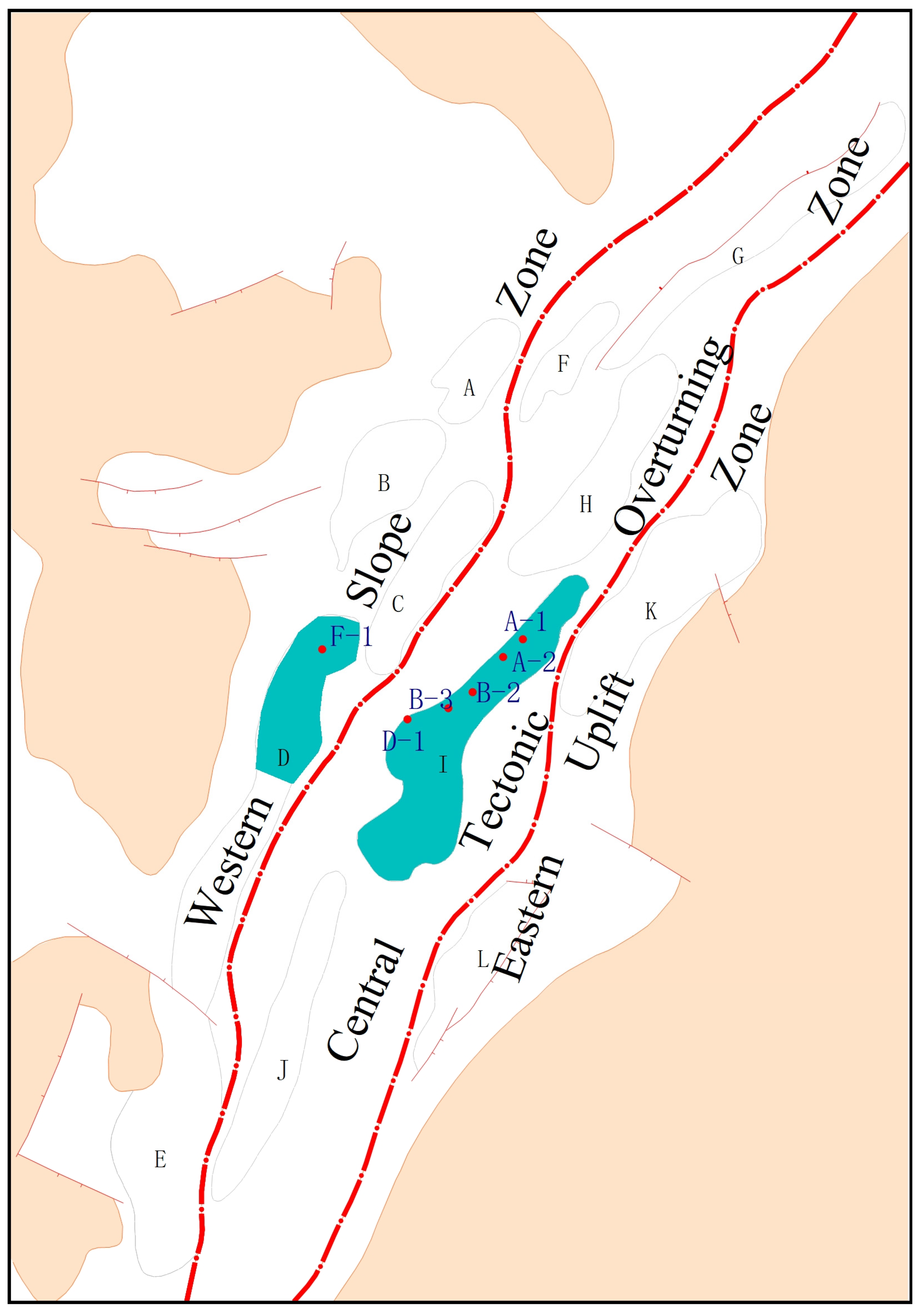
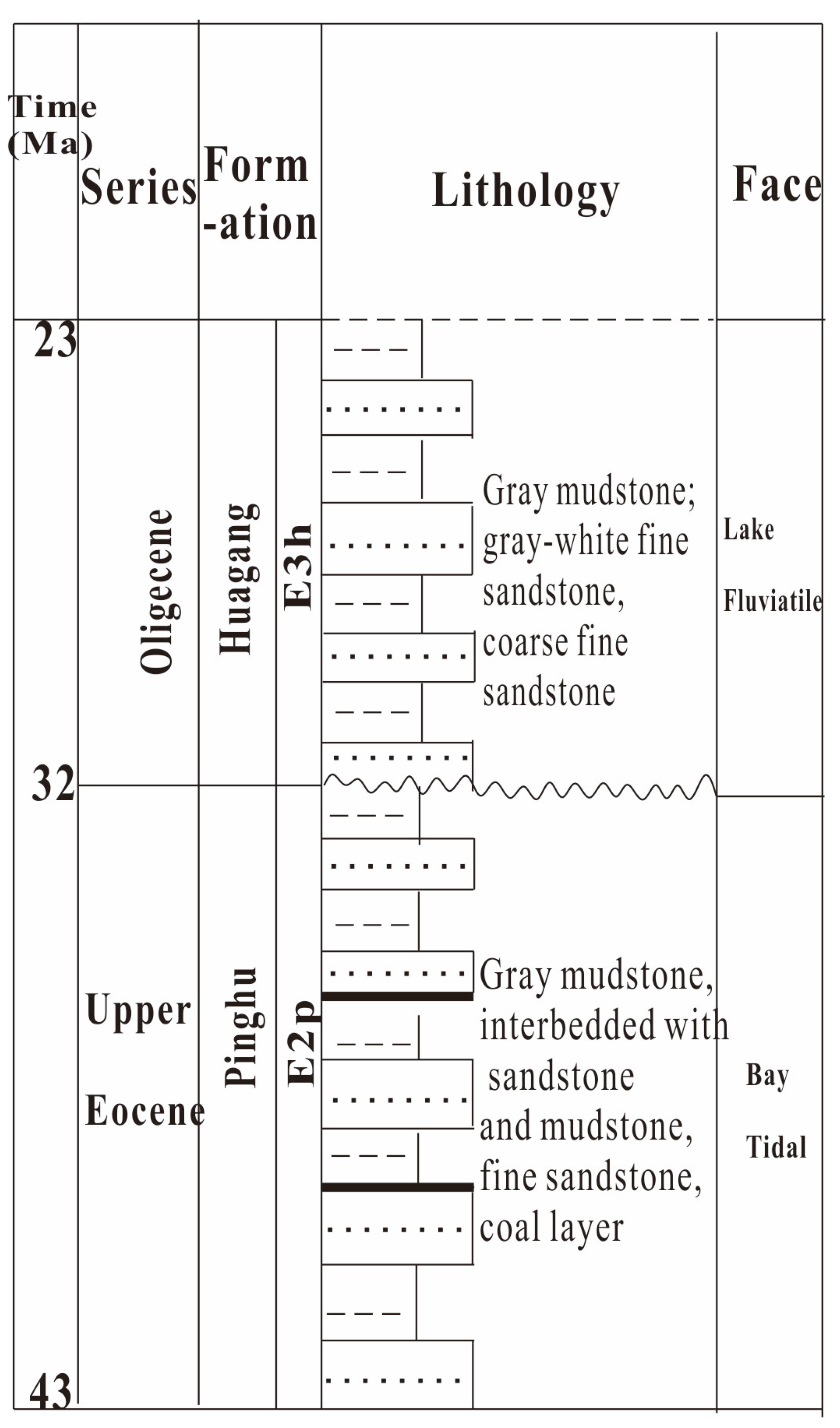


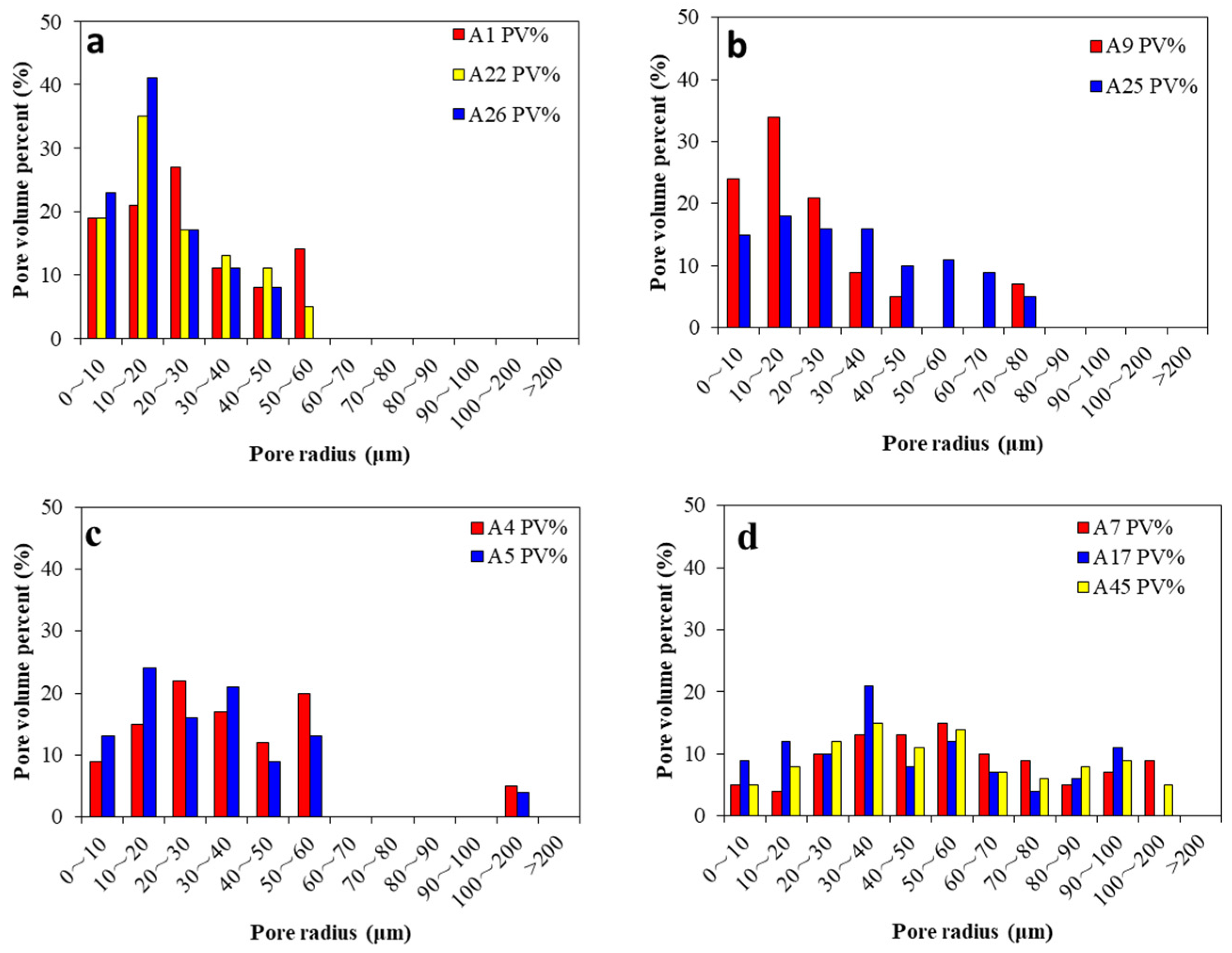

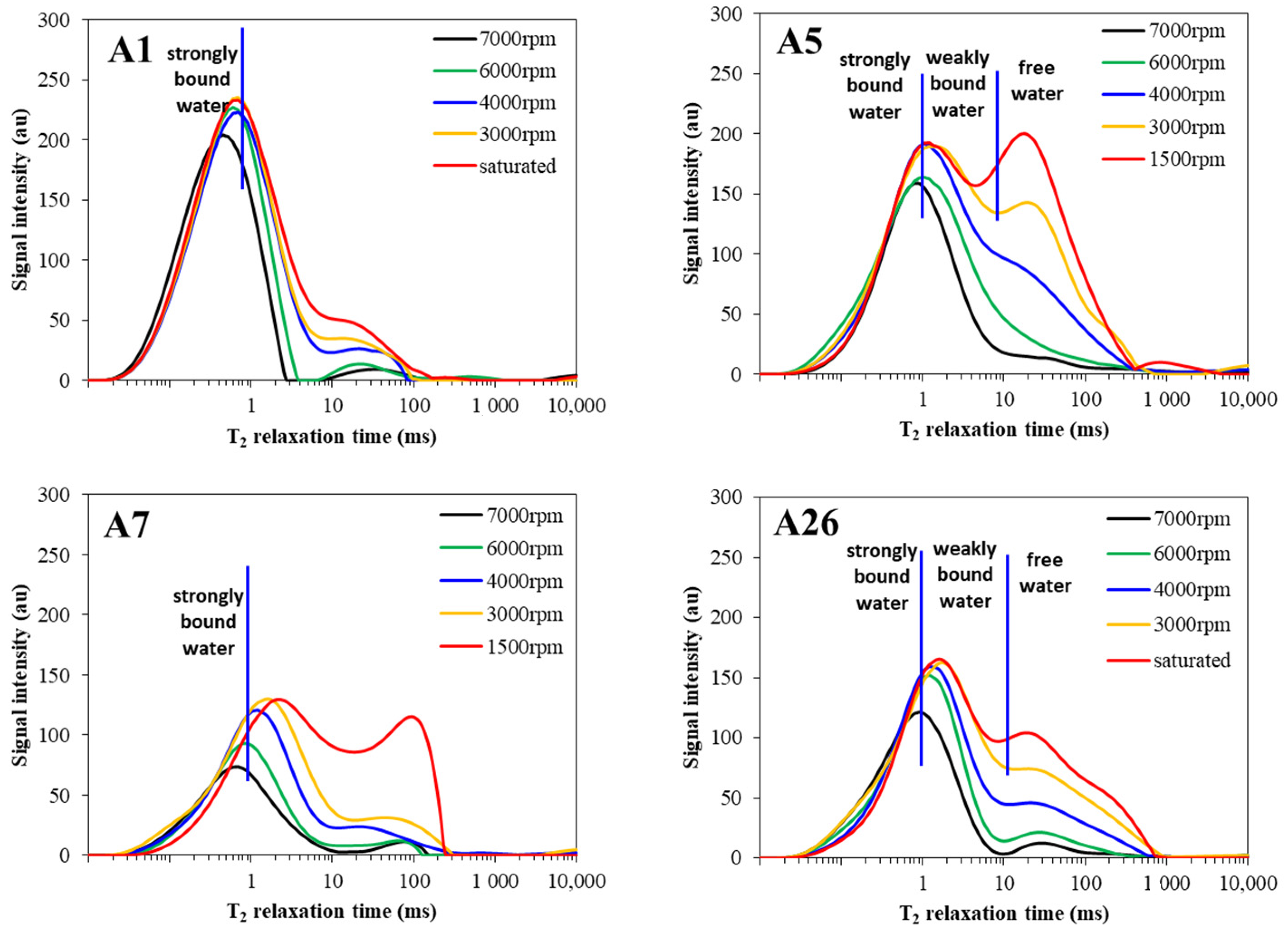

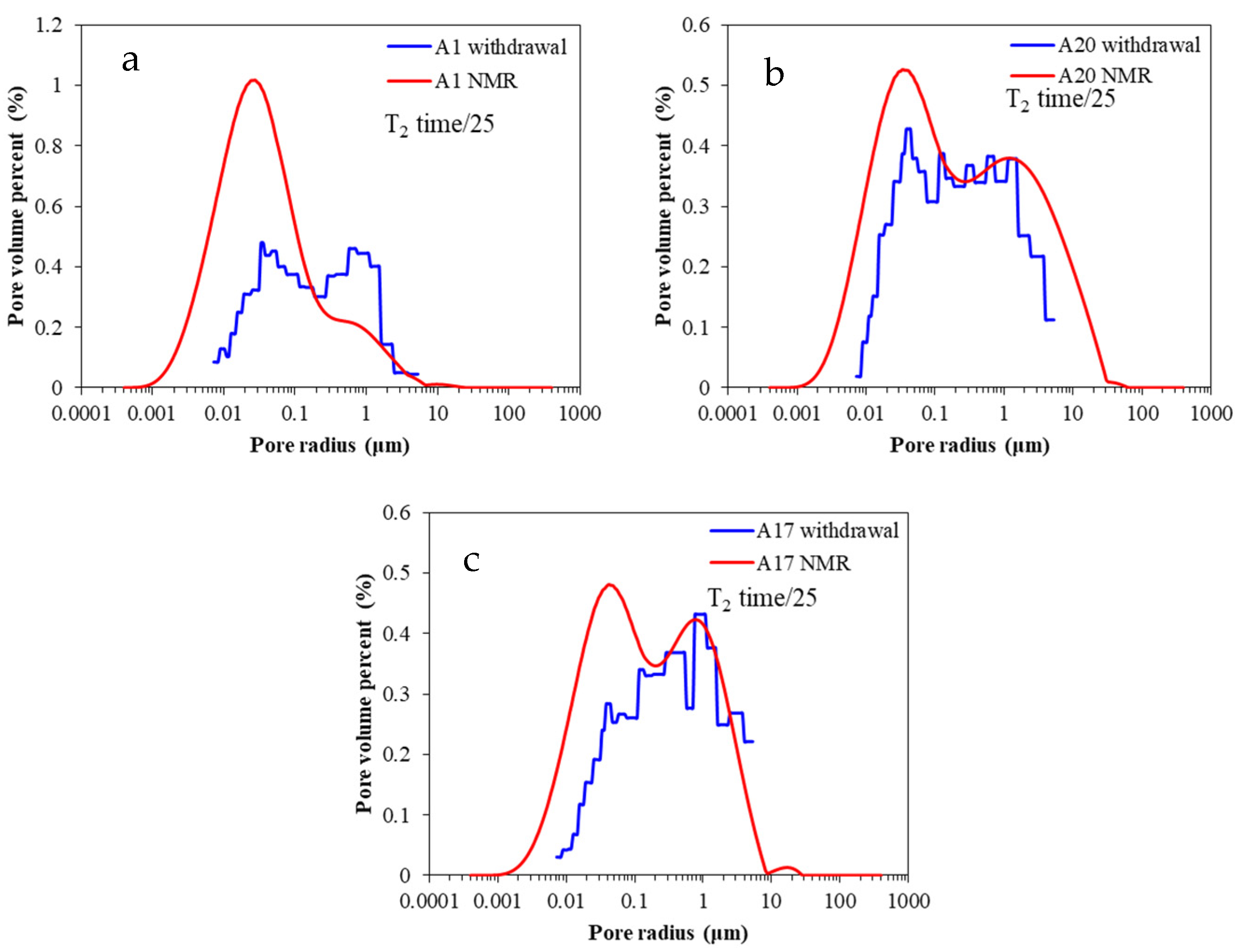
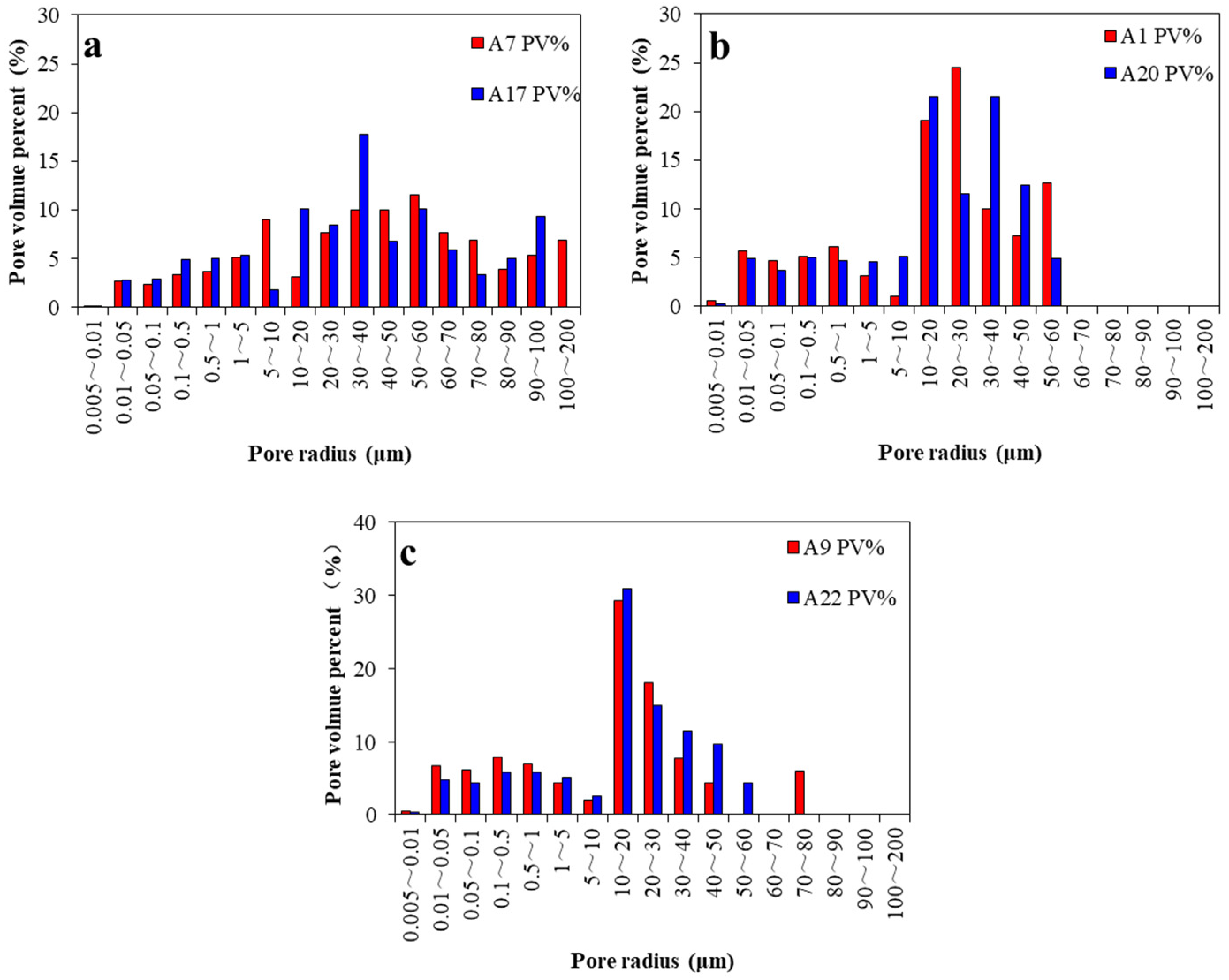
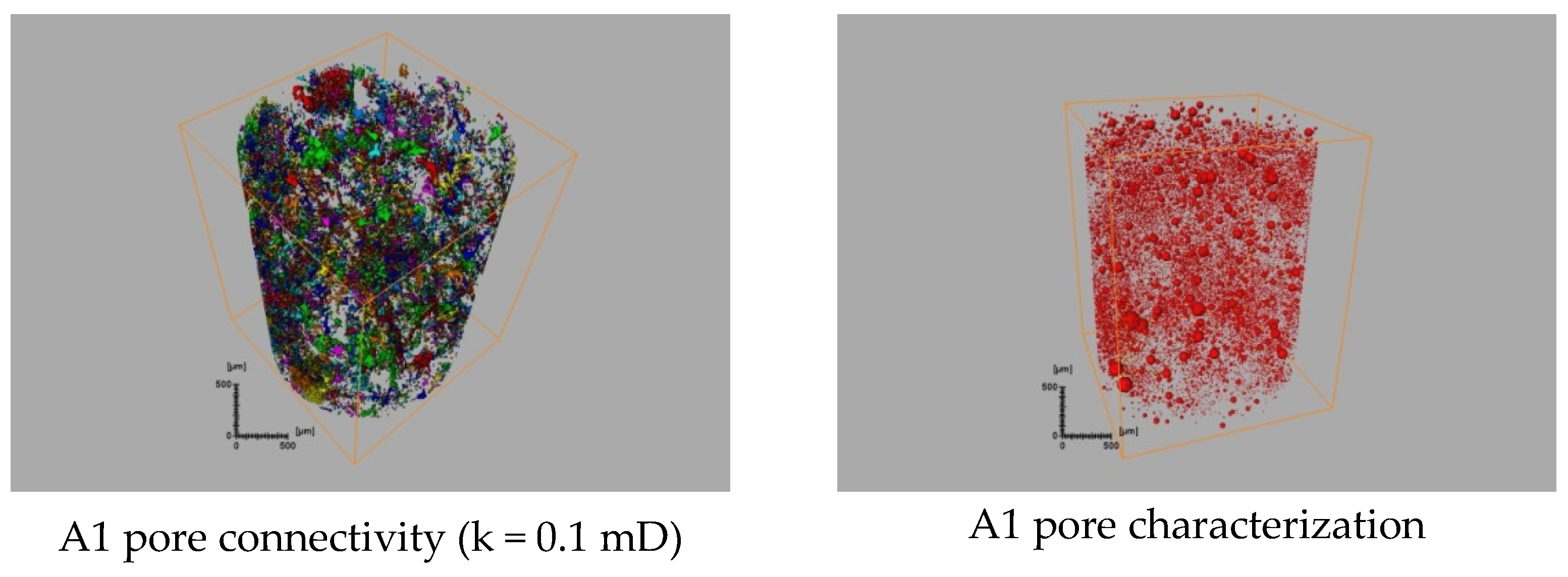

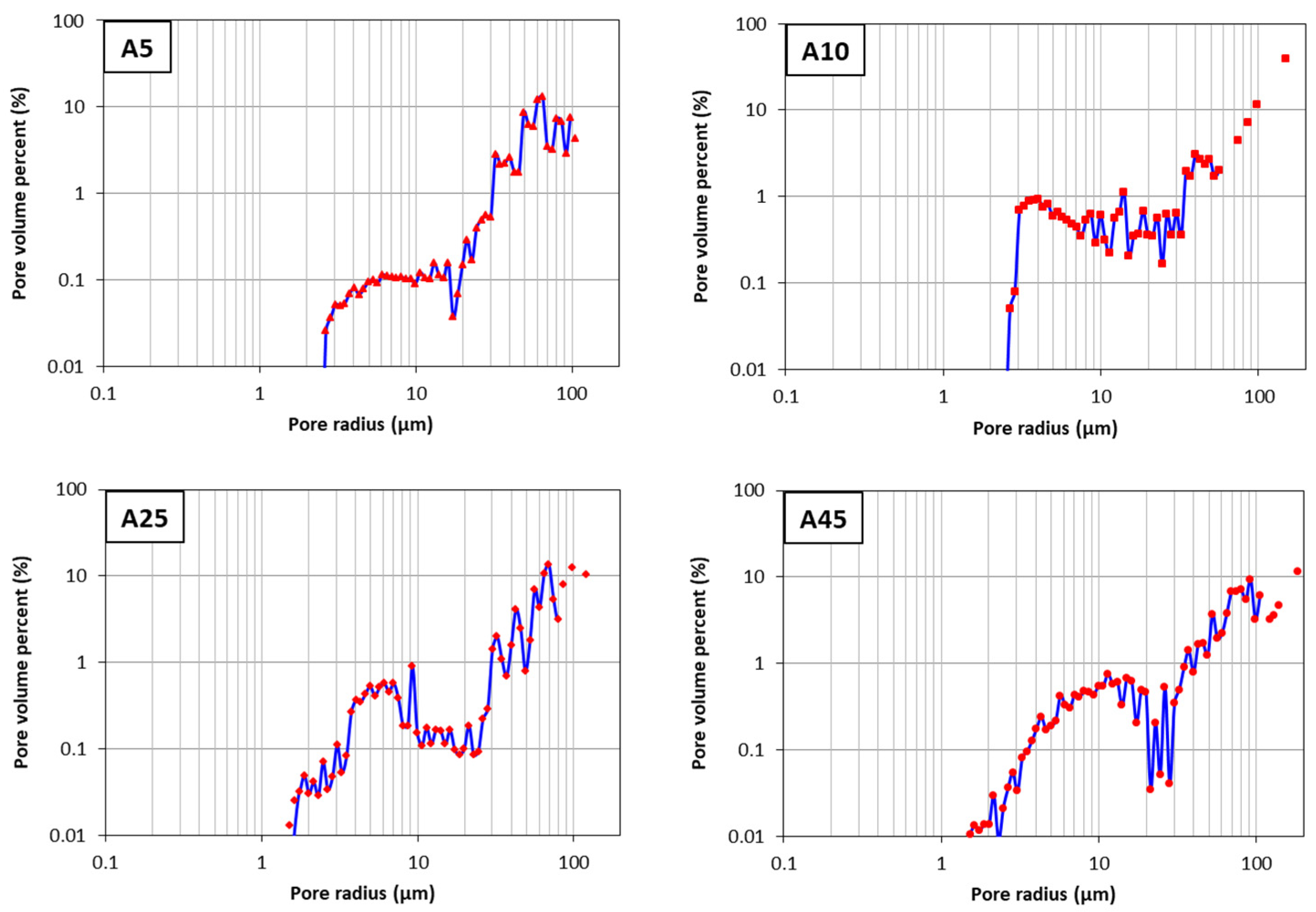
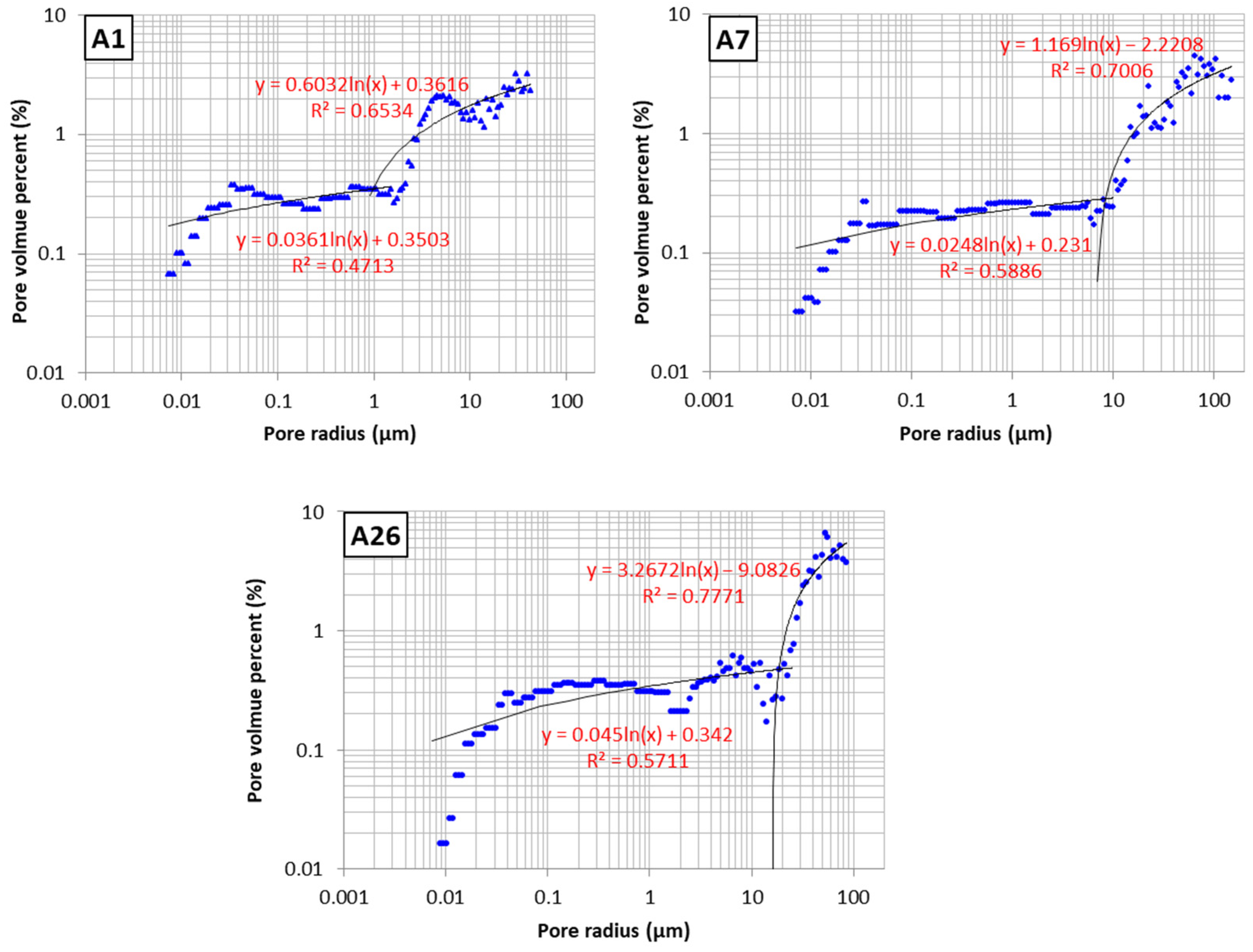
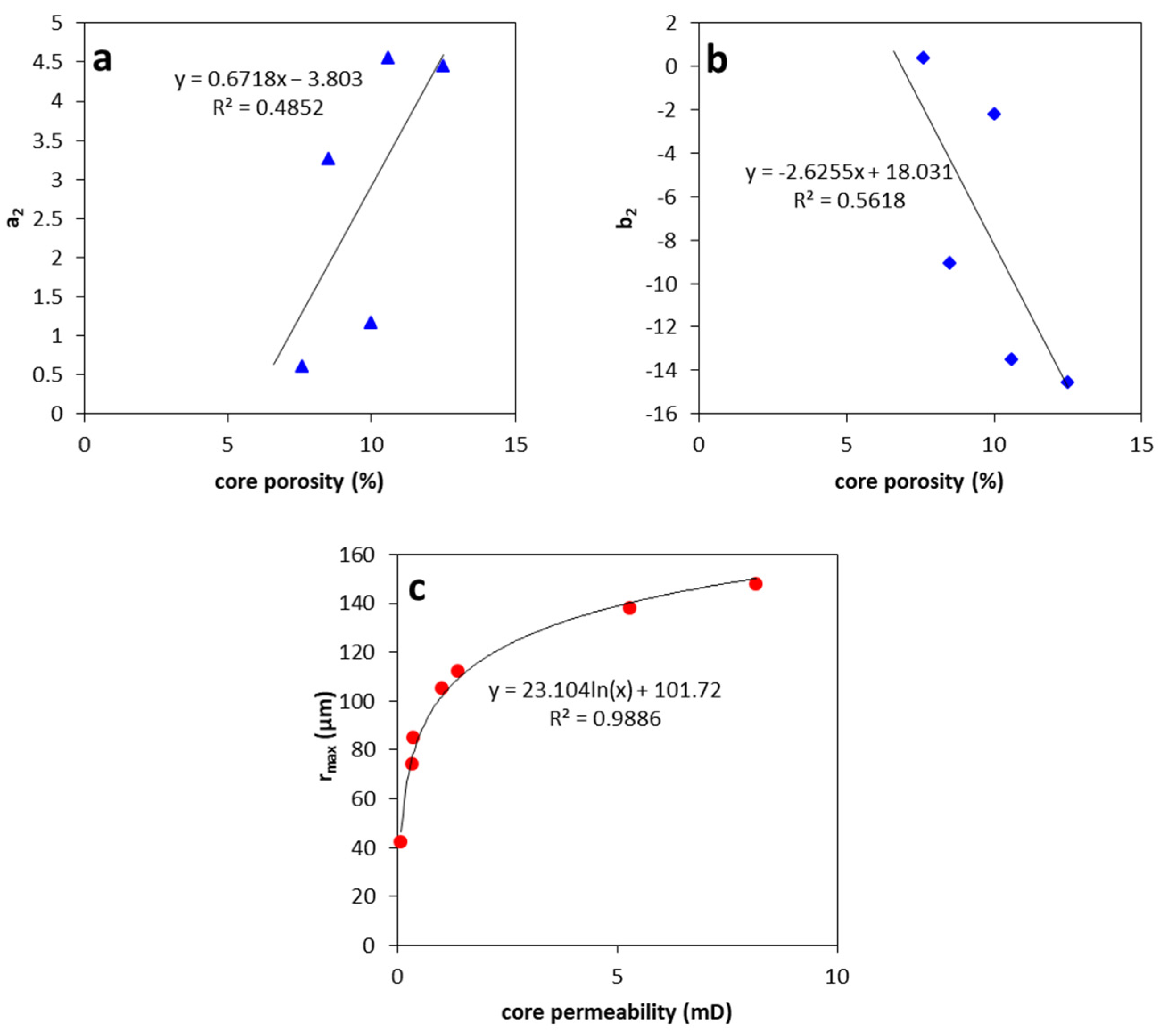
| No. | Well No. | Horizon | Practical Depth/m | Lithology | Porosity/Φ | Permeability/K | CT Scanning | Water-Saturated NMR | Centrifuged NMR | MICP | SEM | Cast Thin Section Imaging |
|---|---|---|---|---|---|---|---|---|---|---|---|---|
| A1 | A-1 | H3 | 3449 | Siltstone | 7.6 | 0.091 | √ | √ | √ | √ | √ | √ |
| A4 | A-1 | H4 | 3823.1 | Siltstone | 11.2 | 1.946 | √ | √ | √ | √ | ||
| A5 | A-1 | H4 | 3831.6 | Fine sandstone | 10.6 | 1.018 | √ | √ | √ | √ | ||
| A7 | A-2 | H3 | 3614.9 | Fine sandstone | 10 | 8.152 | √ | √ | √ | √ | √ | √ |
| A9 | A-2 | H6 | 4318.9 | Fine sandstone | 6.6 | 0.169 | √ | √ | √ | √ | ||
| A10 | A-2 | H6 | 4320.9 | Siltstone | 8 | 0.344 | √ | √ | √ | |||
| A17 | B-2 | H3b | 3752.7 | Siltstone | 10.7 | 2.623 | √ | √ | √ | √ | ||
| A20 | B-2 | H4b | 4008 | Fine sandstone | 7.5 | 0.291 | √ | √ | √ | √ | ||
| A22 | B-3 | H5a | 4300.7 | Siltstone | 7.4 | 0.324 | √ | √ | √ | √ | ||
| A25 | D-1 | H3 | 4324.9 | Fine sandstone | 8.2 | 1.394 | √ | √ | √ | |||
| A26 | D-1 | H8 | 5106.9 | Fine sandstone | 8.5 | 0.369 | √ | √ | √ | √ | √ | √ |
| A45 | F-1 | P10 | 4106.86 | Medium sandstone | 12.5 | 5.292 | √ | √ | √ |
| Pore Radius μm | A1 Volume % | A4 Volume % | A5 Volume % | A7 Volume % | A9 Volume % | A10 Volume % | A17 Volume % | A20 Volume % | A22 Volume % | A25 Volume % | A26 Volume % | A45 Volume % |
|---|---|---|---|---|---|---|---|---|---|---|---|---|
| 0~10 | 19 | 9 | 13 | 5 | 24 | 13 | 9 | 13 | 19 | 15 | 23 | 5 |
| 10~20 | 21 | 15 | 24 | 4 | 34 | 24 | 12 | 26 | 35 | 18 | 41 | 8 |
| 20~30 | 27 | 22 | 16 | 10 | 21 | 20 | 10 | 14 | 17 | 16 | 17 | 12 |
| 30~40 | 11 | 17 | 21 | 13 | 9 | 18 | 21 | 26 | 13 | 16 | 11 | 15 |
| 40~50 | 8 | 12 | 9 | 13 | 5 | 15 | 8 | 15 | 11 | 10 | 8 | 11 |
| 50~60 | 14 | 20 | 13 | 15 | 10 | 12 | 6 | 5 | 11 | 14 | ||
| 60~70 | 10 | 7 | 9 | 7 | ||||||||
| 70~80 | 9 | 7 | 4 | 5 | 6 | |||||||
| 80~90 | 5 | 6 | 8 | |||||||||
| 90~100 | 7 | 11 | 9 | |||||||||
| 100~200 | 5 | 4 | 9 | 5 | ||||||||
| >200 |
| No. | Lithology | Measured/Φ | Measured/K | Length/cm | Diameter/cm | Dry Weight/g | Water Saturated/g | Water Imbibed/g | Water Immersion Porosity/Φ |
|---|---|---|---|---|---|---|---|---|---|
| A1 | Siltstone | 7.6 | 0.091 | 3.71 | 2.47 | 44.8377 | 45.8624 | 1.0247 | 5.8 |
| A4 | Siltstone, fine sandstone | 11.2 | 1.946 | 4.07 | 2.47 | 45.999 | 47.8797 | 1.8807 | 9.6 |
| A5 | Fine sandstone | 10.6 | 1.018 | 3.64 | 2.47 | 41.599 | 43.2309 | 1.6319 | 9.4 |
| A7 | Fine sandstone | 10 | 8.152 | 3.53 | 2.47 | 40.6202 | 42.1702 | 1.55 | 9.2 |
| A9 | Fine sandstone | 6.6 | 0.169 | 4.11 | 2.48 | 49.1435 | 50.295 | 1.1515 | 5.8 |
| A10 | Siltstone, fine sandstone | 8 | 0.344 | 3.36 | 2.48 | 40.0286 | 41.0928 | 1.0642 | 6.6 |
| A17 | Siltstone, fine sandstone | 10.7 | 2.623 | 4.03 | 2.51 | 47.047 | 49.0348 | 1.9878 | 10 |
| A20 | Fine sandstone | 7.5 | 0.291 | 4.07 | 2.47 | 47.9825 | 49.1404 | 1.1579 | 5.9 |
| A22 | Siltstone, fine sandstone | 7.4 | 0.324 | 4.15 | 2.48 | 48.8936 | 50.1391 | 1.2455 | 6.2 |
| A25 | Fine sandstone | 8.2 | 1.394 | 3.47 | 2.49 | 41.5419 | 42.7109 | 1.169 | 6.9 |
| A26 | Fine sandstone | 8.5 | 0.369 | 3.39 | 2.47 | 39.6837 | 40.8165 | 1.1328 | 7 |
| A45 | Medium sandstone | 12.5 | 5.292 | 3.05 | 2.49 | 34.982 | 36.5207 | 1.5387 | 10.4 |
| Mercury Withdrawal | r μm | A1 % | A4 % | A7 % | A9 % | A17 % | A20 % | A22 % | A26 % |
|---|---|---|---|---|---|---|---|---|---|
| 0.13 | 5.33 | 43.3 | 61.4 | 56.4 | 51.7 | 71.7 | 55.4 | 47.5 | 51.2 |
| 0.19 | 3.82 | 43.5 | 62.9 | 57.8 | 52.1 | 72.8 | 56.0 | 48.0 | 52.1 |
| 0.32 | 2.26 | 43.8 | 65.2 | 59.9 | 53.0 | 74.6 | 57.5 | 49.4 | 53.9 |
| 0.47 | 1.56 | 44.7 | 67.2 | 61.4 | 54.6 | 76.1 | 59.0 | 51.1 | 55.5 |
| 0.68 | 1.08 | 46.7 | 69.6 | 63.0 | 56.8 | 78.0 | 60.9 | 53.2 | 57.4 |
| 1 | 0.716 | 49.4 | 72.1 | 64.9 | 59.8 | 80.6 | 63.0 | 55.8 | 59.7 |
| 1.3 | 0.539 | 51.2 | 73.9 | 66.1 | 62.0 | 81.7 | 64.5 | 57.5 | 61.5 |
| 2.1 | 0.357 | 53.5 | 76.1 | 67.8 | 65.0 | 83.9 | 66.5 | 59.9 | 64.2 |
| 2.7 | 0.268 | 54.9 | 77.6 | 68.9 | 67.2 | 85.4 | 68.0 | 61.5 | 66.1 |
| 4.1 | 0.178 | 56.7 | 79.5 | 70.3 | 70.1 | 87.4 | 70.0 | 63.7 | 68.8 |
| 5.5 | 0.133 | 58.1 | 80.7 | 71.4 | 72.4 | 88.7 | 71.4 | 65.3 | 70.6 |
| 7 | 0.106 | 59.1 | 81.6 | 72.2 | 74.1 | 89.7 | 72.5 | 66.5 | 72.0 |
| 10 | 0.0712 | 61.3 | 83.3 | 73.8 | 77.7 | 91.3 | 74.4 | 68.8 | 74.3 |
| 13 | 0.0533 | 62.9 | 84.3 | 74.7 | 79.7 | 92.4 | 75.8 | 70.3 | 75.7 |
| 17 | 0.0427 | 64.3 | 85.0 | 75.3 | 81.2 | 93.1 | 76.9 | 71.3 | 76.7 |
| 20 | 0.0356 | 65.6 | 85.7 | 75.9 | 82.7 | 94.0 | 78.2 | 72.7 | 77.8 |
| 25 | 0.0305 | 66.6 | 86.2 | 76.6 | 84.0 | 94.5 | 79.0 | 73.5 | 78.4 |
| 30 | 0.0237 | 67.8 | 86.9 | 77.4 | 85.8 | 95.2 | 80.4 | 74.5 | 79.2 |
| 40 | 0.0178 | 69.1 | 87.4 | 78.1 | 87.3 | 95.8 | 81.4 | 75.5 | 79.9 |
| 50 | 0.0142 | 69.8 | 87.8 | 78.4 | 88.2 | 96.2 | 82.2 | 76.2 | 80.3 |
| 60 | 0.0118 | 70.4 | 87.9 | 78.7 | 88.8 | 96.4 | 82.7 | 76.6 | 80.5 |
| 70 | 0.0106 | 70.6 | 88.0 | 78.8 | 89.0 | 96.5 | 82.9 | 76.7 | 80.6 |
| 85 | 0.00853 | 71.0 | 88.0 | 78.9 | 89.5 | 96.6 | 83.1 | 76.9 | 80.7 |
| 100 | 0.00725 | 71.2 | 88.0 | 79.1 | 89.7 | 96.7 | 83.2 | 77.1 | 80.7 |
Disclaimer/Publisher’s Note: The statements, opinions and data contained in all publications are solely those of the individual author(s) and contributor(s) and not of MDPI and/or the editor(s). MDPI and/or the editor(s) disclaim responsibility for any injury to people or property resulting from any ideas, methods, instructions or products referred to in the content. |
© 2023 by the authors. Licensee MDPI, Basel, Switzerland. This article is an open access article distributed under the terms and conditions of the Creative Commons Attribution (CC BY) license (https://creativecommons.org/licenses/by/4.0/).
Share and Cite
Chen, J.; Huang, Z.; Yao, G.; Zhang, W.; Pan, Y.; Qu, T. Analysis Method of Full-Scale Pore Distribution Based on MICP, CT Scanning, NMR, and Cast Thin Section Imaging—A Case Study of Paleogene Sandstone in Xihu Sag, East China Sea Basin. Processes 2023, 11, 1869. https://doi.org/10.3390/pr11071869
Chen J, Huang Z, Yao G, Zhang W, Pan Y, Qu T. Analysis Method of Full-Scale Pore Distribution Based on MICP, CT Scanning, NMR, and Cast Thin Section Imaging—A Case Study of Paleogene Sandstone in Xihu Sag, East China Sea Basin. Processes. 2023; 11(7):1869. https://doi.org/10.3390/pr11071869
Chicago/Turabian StyleChen, Jinlong, Zhilong Huang, Genshun Yao, Weiwei Zhang, Yongshuai Pan, and Tong Qu. 2023. "Analysis Method of Full-Scale Pore Distribution Based on MICP, CT Scanning, NMR, and Cast Thin Section Imaging—A Case Study of Paleogene Sandstone in Xihu Sag, East China Sea Basin" Processes 11, no. 7: 1869. https://doi.org/10.3390/pr11071869
APA StyleChen, J., Huang, Z., Yao, G., Zhang, W., Pan, Y., & Qu, T. (2023). Analysis Method of Full-Scale Pore Distribution Based on MICP, CT Scanning, NMR, and Cast Thin Section Imaging—A Case Study of Paleogene Sandstone in Xihu Sag, East China Sea Basin. Processes, 11(7), 1869. https://doi.org/10.3390/pr11071869





